Like a samurai poised patiently for an opening in their opponent’s defences, Shogun Showdown understands that focus and finesse are the means to delivering an impactful blow. This rare roguelike distils the genre down to its purest components, all in favour of amplifying its dizzying combat that plays gracefully with the concepts of positioning and patience. Highly refined, stylish and complex, Shogun Showdown is a delight.
Here’s the pitch: you are on a quest to kill the Shogun. The Shogun is a Bad Dude, corrupted by some kind of cataclysmic event that has shaken the earth, dark forces gushing free from the resulting cracks. At least, I think that’s what’s going on? Shogun Showdown is pretty light on story, to be honest, and outside of a few small cutscenes, there’s not much to chew on here. At first, I found this decision concerning, before it became apparent after a few hours of play that like most aspects of the game, this was simply more evidence of developer Roboatino’s careful intent.
Shogun Showdown is a roguelike in the most traditional sense of the term. All the genre staples you’d expect are here: a node-based map, shops, and bosses. Unlockable characters, weapons, and skills. There’s no fat to trim here, no additional runes that dole out minute percentage boosts or fancy narrative conceits to incentivise or reward death. You get a single currency used to buy more stuff,and that’s it: everything is in service of the combat, repeatedly funnelling you into its excellent clashes.
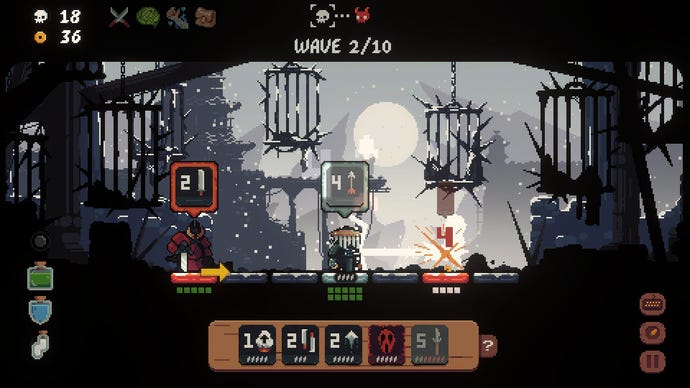 Combat is crunchy and satisfying, your attacks carrying a weight that makes each takedown feel like an event.
| Image credit: Rock Paper Shotgun/Goblinz Publishing/Gamera Games
Combat is crunchy and satisfying, your attacks carrying a weight that makes each takedown feel like an event.
| Image credit: Rock Paper Shotgun/Goblinz Publishing/Gamera Games
A turn-based twist on the genre, positioning is your most important weapon against the Shogun’s hordes. At the start of a run, you are placed in the centre of a row of tiles. Movement is locked to single hops left and right, but you can also flip around to face the other way. Attacks, stylised as cards at the bottom of the screen, can be dragged above your character’s head to define the order in which they’ll be performed. Once a card has been used, you’re forced to wait a brief cooldown period before it can be primed again.
Every action (except for specific cards) takes up a turn. Whether you decide to move to your left or prime your bow for an attack, the baddies chilling around you will also make a decision at the same time. Their actions are visualised on screen alongside your own, their upcoming movements or combat abilities displayed on their body or above their head. Attacks that will be performed after your next move, meanwhile, flash yellow to encourage you to get out of their way, lest you be diagnosed with a terminal case of Large Sword In The Chest Disease.
Considering all of your attacks are tied to cooldowns, and the arenas you fight within are as cramped as a London house share (often stuffed full of as many people, too), every choice you make becomes the difference between life and death. Thankfully, your options are plentiful, the result of a rich and diverse selection of weapons and perks handed over with generous frequency as you pick your way through the game.
Although some weapons are pure damage dealers, most could be better described as movement modifiers. A dash that flings you across the arena. A smoke bomb that switches your character’s position with that of your closest opponent’s. A grappling hook that pulls an enemy into the tip of your blade. Combined with character abilities (starting character Wanderer can swap places with whoever she’s facing, whereas the unlockable Ronin shoves enemies into their allies, the impact reducing them to a fountain of blood) weapons encourage you to consider your broader strategy every single turn. You can’t coast by on brute force alone.
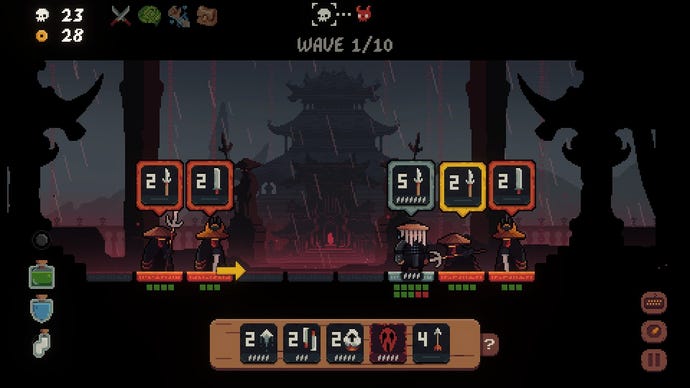 Spears can strike across two tiles in front, making them trickier to avoid when the arena becomes cramped. Thankfully, my spear is also primed, meaning both the attacker and the swordsman relaxing behind them are about to get a horrible surprise (death). | Image credit: Rock Paper Shotgun/Goblinz Publishing/Gamera Games
Spears can strike across two tiles in front, making them trickier to avoid when the arena becomes cramped. Thankfully, my spear is also primed, meaning both the attacker and the swordsman relaxing behind them are about to get a horrible surprise (death). | Image credit: Rock Paper Shotgun/Goblinz Publishing/Gamera Games
It’s astonishing stuff. Despite being turn-based, the drama it generates is a testament to the breadth of imagination on display within the design of these weapons. After only a few hours of play, it becomes apparent that no two encounters will ever be dealt with in the same way. You begin each run with two default weapons, but can only pick from your unlocked pool after specific rounds. You’ll rarely have access to more than a handful of attacks, basically, and although during a run they can be upgraded to boost their power, reduce their cooldown or become imbued with a helpful ability, the volume of fiddling you can do to each one is capped.
In practice, all this creates a huge amount of spectacle despite being locked to a single 2D plane. To play Shogun Showdown is to find yourself stuck between two enraged fighters with no clear solution on how to avoid certain death. Do you jump out of the way of the Ashigaru’s katana, only to be pierced by his friend’s spear instead? Do you loosen a crossbow bolt, knowing that its ability to cut through multiple enemies at once would be more beneficial once you’re able to turn around to face the group behind you? Ah! Wait! What if you swap places with katana boy using a smoke bomb instead, causing him to strike down his pal in the resulting confusion? Brilliant!
It’s here, amid this process of fraught decision-making, that Shogun Showdown reveals its breathless, exhilarating core. Ducking and weaving. Pushing and pulling. Slicing, dicing, bludgeoning and cursing. This is combat at its most exciting, despite its relative simplicity. Battles are either hard-won (with defeat averted at the last minute by a well-timed health potion or the slice of a sword that cleaves your two remaining enemies into chunks) or achieved with such ferocity and speed that the game has no choice but to plaster the words “Obliterated” over the screen (which, just as a side note, feels really good).
Who needs real-time action when turn-based battles like this can conjure such moments of brilliance? After one particularly memorable battle, I shouted so loud that I received a gentle text from my partner asking me to keep it down. In her defence, it was 2am. Such is the time-deleting joy this game provides in abundance.
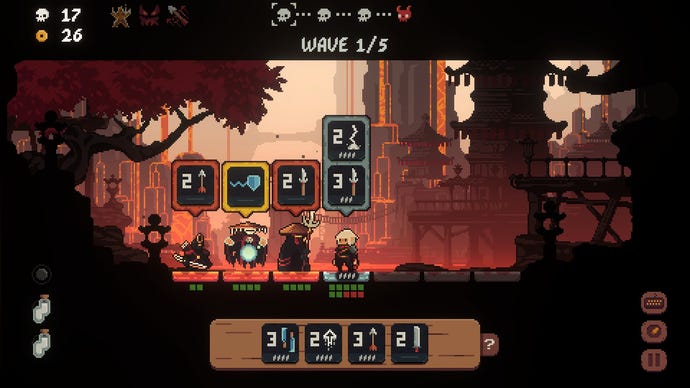 Floating enemies can mimic one of your attacks at random, leading to some nasty situations where your best weapon is used against you. | Image credit: Rock Paper Shotgun/Goblinz Publishing/Gamera Games
Floating enemies can mimic one of your attacks at random, leading to some nasty situations where your best weapon is used against you. | Image credit: Rock Paper Shotgun/Goblinz Publishing/Gamera Games
I’ll tell you what, it helps that it’s a looker. With most aspects of the game pruned to perfection, the art is no exception. Each stage is framed beautifully, with multiple layers providing a sense of depth that, combined with the combat, lends it an effective cinematic quality. Fights play out surrounded by silhouetted flora, splintered pagodas bathed in sunset-hued light, scattered loosely behind the bloodshed. Backgrounds in particular are a highlight - detailed vistas convey a sense of rot and corruption that has tainted this sparse world - but in truth, all aspects of the game, from its characters to its UI, are readable and pretty.
And when it’s done? Well. A good roguelike is never truly done, is it? All I’ll say is that defeating the Shogun is far from the end, with more difficult challenges awaiting those brave enough to venture forth after the titular ruler is toppled. Even then, there are always new tactics to discover, new toys to play with, and new characters to be trialled on the battlefield. I fear my time with the game is far from over (complimentary).
2024 has been such an excellent year for roguelikes that I was convinced I had already had my fill. How, in a year that has already provided both Balatro and Hades II, could something of equal quality make a genuine attempt to steal the crown? More fool me, I suppose. After playing Shogun Showdown, it comes as no surprise that it has ducked and weaved its way into my life with such grace that I barely even noticed the blade it slipped into my heart. This is a dazzling gem of a game you simply cannot miss, even if you do get smoke-bombed.

 3 weeks ago
6
3 weeks ago
6
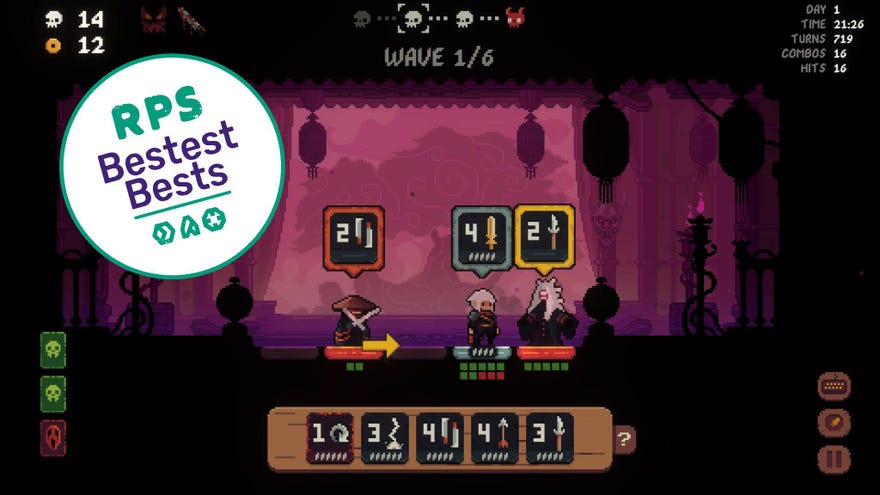






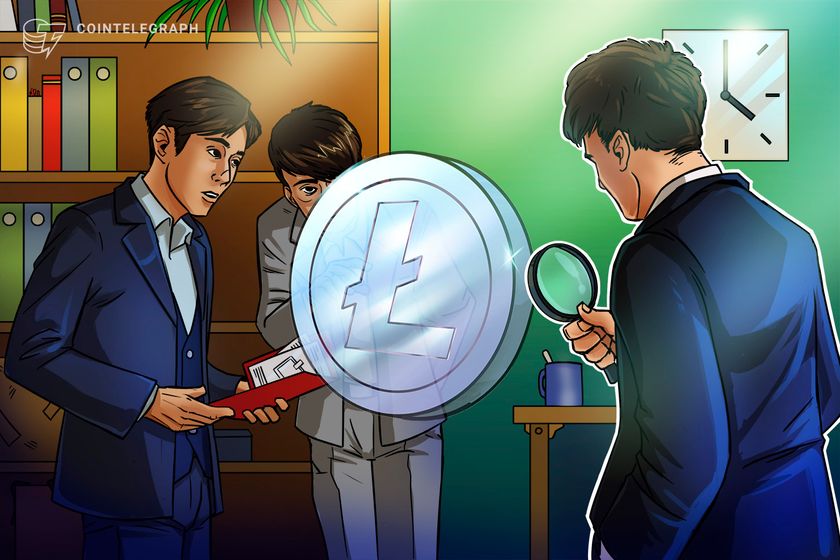

 English (US) ·
English (US) ·